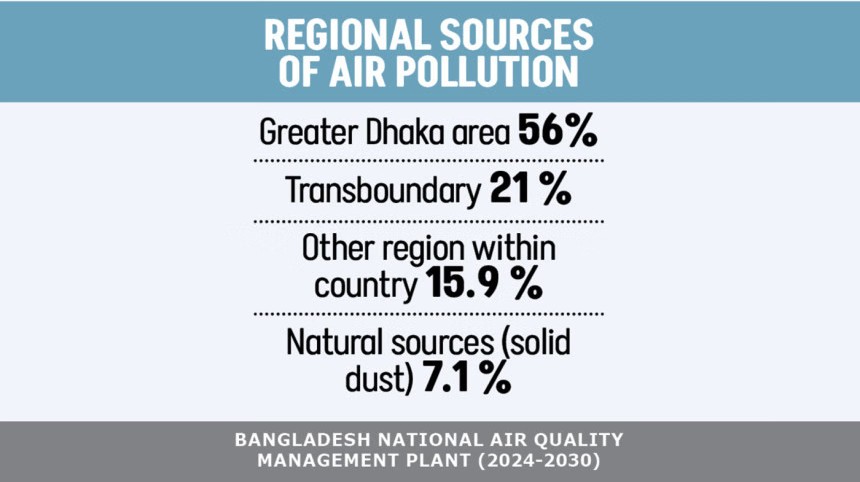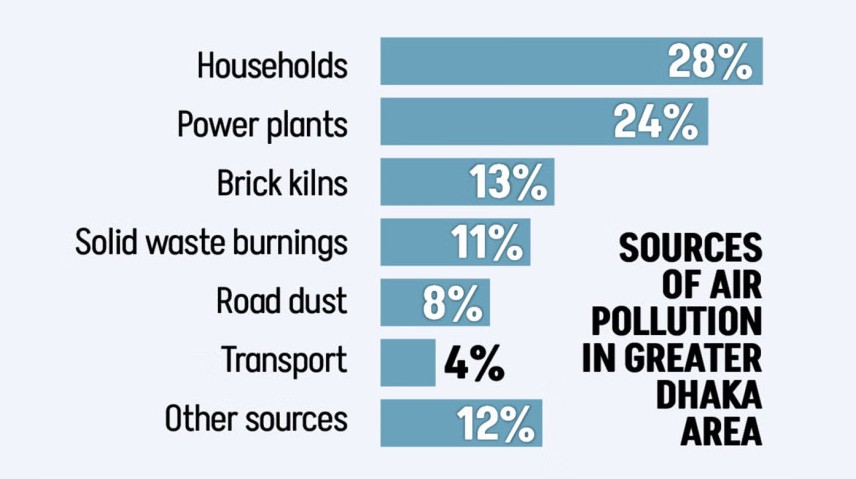With the dry season approaching, Dhaka city’s air quality has once again slipped to an unhealthy level, underscoring the inadequacy of the limited measures taken by the authorities to curb air pollution.
Over the past decade, the government has attempted to phase out clay bricks, curb the burning of solid waste, control dust pollution at construction sites, and remove old vehicles from roads. But it has failed to properly implement any of the initiatives.
According to the Department of Environment (DoE) data, the air quality in Dhaka city and its suburbs was classified as hazardous for sensitive groups over the past week. The Air Quality Index (AQI) in these areas hovered between 150 and 200 — well above the threshold of 50, which is considered healthy.
The DoE website issued a warning, “People are advised to wear masks when outdoors, while those belonging to sensitive groups are urged to stay indoors.”
Sensitive groups include children, the elderly, pregnant women, and individuals with pre-existing heart or lung diseases, who are more vulnerable to the effects of air pollutants.
The AQI is a standardised system used globally to measure air pollution levels. It assesses the concentration of particulate matter (PM2.5), an extremely hazardous substance for human health, along with other pollutants.
In Dhaka city, the level of PM2.5 — particles smaller than 2.5 micrograms — ranged between 64 and 79.7 micrograms per cubic metre from October 14 to 20 — more than double the national standard of 35 micrograms and over 12 times the threshold of 5 micrograms set by the World Health Organisation (WHO).
Though the WHO threshold for PM2.5 is 5 micrograms, Bangladesh has set the benchmark at 35 micrograms, considering that it would be almost impossible to achieve the global standard in the near future.
Between 1998 and 2023, the country’s PM2.5 pollution surged by 66 percent, said the global annual report of the Air Quality Life Index (AQLI), published by the Energy Policy Institute of the University of Chicago.
In 2023, the annual average PM2.5 concentration across the country was 60.8 micrograms per cubic metre. In Dhaka city, it was between 90 and 100 micrograms.
The high level of air pollution reduces the average life expectancy of Bangladeshis by five and a half years, making it the country’s deadliest external health risk, said the report.
A recent global study has revealed that in Bangladesh, more than 19,000 children under five died due to air pollution in 2021, meaning two children died per hour.
Dhaka city and its suburbs at times top the global list of places with worst air quality. This year, Dhaka or other cities of Bangladesh had the worst air quality in the world for a total of 16 days from January to August this year; 29 days last year; 17 days in 2023; and 19 days in 2022, according to DoE data.
When asked, Ziaul Haque, director of the Department of Environment (DoE), said, “We observe a sharp deterioration in air quality between October and March each year, when brick kilns become active and wind patterns shift, carrying pollutants into the city from the northwestern region of the country.”
“Around 25 percent of fine particulate [PM2.5] pollution originates from transboundary sources, which are beyond our control. Air pollutants generated in Lahore, Punjab, New Delhi, Jharkhand, Bihar, and West Bengal drift into Bangladesh,” he added.
He further said the government has taken some initiatives in recent times to curb air pollution but those appear to be insufficient.
“If we truly want to curb air pollution, different government agencies, such as city corporations and the roads and highways department, must work together.”

“We will not allow any of the 106 conventional brick kilns in the upazila to resume operations.”
He said city corporations must stop burning solid waste at dumping grounds and take steps to check pollution at construction sites. “But they are failing us all.”
Regarding recent government initiatives, Ziaul said Savar upazila has been declared a “degraded airshed”, prohibiting operations of all brick kilns, except for environment-friendly units, and the burning of solid waste and garbage from next month.
Ahmad Kamruzzaman Majumder, professor of environmental science at Stamford University Bangladesh, said the authorities have not been able to enforce any of the measures to contain dust pollution at construction sites, remove polluting vehicles from roads or stop operations of illegal brick kilns.
“After the interim government took office, I was included in a taskforce on preventing air pollution. But it became inactive after holding a couple of meetings.”
HEALTH IMPACTS
Exposure to air pollution leads to a wide range of health complications — from respiratory diseases to impaired cognitive performance — and children are particularly vulnerable to the harmful effects.
Children in developing countries like Bangladesh are 94 times more likely to die from air pollution than those in developed nations, according to a study titled “Structural Dependencies Perpetuate Disproportionate Childhood Health Burden from Air Pollution” released on October 16.
Earlier, a World Bank report published in 2023 said more than 159,000 lives were lost and 2.5 billion days were lived with illness in 2019. The cost of these health effects was estimated to be equivalent to 8.3 percent of Bangladesh’s GDP that year.
PERSISTENT SOURCES, LIMITED SOLUTIONS
Air pollution in Dhaka stems from a combination of industrial activity and urban mismanagement. More than 7,000 traditional brick kilns operate across the country, most of which lack modern emission controls.
At least 56 percent of emissions originate within the greater Dhaka area, while 15.9 percent come from other regions, nearly 21 percent from other countries, and 7.1 percent from natural sources such as soil dust, according to the National Air Quality Management Plan 2024-2030.
The plan aims to achieve two key targets — reduce the annual concentration of ambient PM2.5 by 15 microgram per cubic metre across Bangladesh and by 30 microgram per cubic meter in the greater Dhaka area, and increase the number of days with “good” or “moderate” AQI across the country.
Environment Adviser Syeda Rizwana Hasan said, “Even with full action, it will take years to reduce air pollution.
“We also need quality fuel, otherwise the air will remain polluted,” she told The Daily Star recently.
Source: dailystar.net





